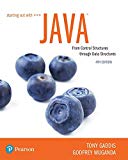
Starting Out with Java: From Control Structures through Data Structures (4th Edition) (What's New in Computer Science)
4th Edition
ISBN: 9780134787961
Author: Tony Gaddis, Godfrey Muganda
Publisher: PEARSON
expand_more
expand_more
format_list_bulleted
Question
Chapter 20.3, Problem 20.5CP
Program Plan Intro
Stack:
- A stack is a linear data structure.
- The stack follows the order LIFO (last-in-first-out) for performing operations.
- The two main operations performed on stack are,
- Push() – Add item to stack.
- Pop() – Remove item from stack.
“Push()” method:
The “Push()” is a method used to insert or add an item to the stack. The element is pushed at the top of the stack.
- The “Push()” will have an item as its argument and it returns the argument which is passed.
- If the stack is full and when “push()” method is calls the push will generate “StackOverFlowException” and return.
Syntax for push operation:
STACK.push(E element)
“Pop()” method:
- The method “pop()” is used to delete an item from the stack.
- This method does not have any argument and when this method called on a stack, the element at the top of the stack is removed.
- This method will return the top element before removing it.
- If the stack is empty (its size is equal to 0) and when the “pop()” method is called pop throws the “EmptyStackException” object.
Syntax for pop operation:
STACK.pop()
Expert Solution & Answer
Want to see the full answer?
Check out a sample textbook solution
Students have asked these similar questions
I need help to solve the following case, thank you
hi I would like to get help to resolve the following case
Could you help me to know features of the following concepts:
- defragmenting.
- dynamic disk.
- hardware RAID
Chapter 20 Solutions
Starting Out with Java: From Control Structures through Data Structures (4th Edition) (What's New in Computer Science)
Ch. 20.3 - Prob. 20.1CPCh. 20.3 - Prob. 20.2CPCh. 20.3 - Prob. 20.4CPCh. 20.3 - Prob. 20.5CPCh. 20.6 - Prob. 20.6CPCh. 20.6 - Prob. 20.7CPCh. 20.6 - Prob. 20.8CPCh. 20.6 - Prob. 20.9CPCh. 20 - Prob. 1MCCh. 20 - Prob. 2MC
Ch. 20 - Prob. 3MCCh. 20 - The concept of seniority, which some employers use...Ch. 20 - Prob. 5MCCh. 20 - Prob. 6MCCh. 20 - Prob. 8TFCh. 20 - Prob. 9TFCh. 20 - Prob. 10TFCh. 20 - Prob. 1FTECh. 20 - Prob. 2FTECh. 20 - Prob. 3FTECh. 20 - Prob. 4FTECh. 20 - Prob. 5FTECh. 20 - Prob. 1AWCh. 20 - Prob. 2AWCh. 20 - Suppose that you have two stacks but no queues....Ch. 20 - Prob. 1SACh. 20 - Prob. 2SACh. 20 - Prob. 3SACh. 20 - Prob. 4SACh. 20 - Prob. 5SACh. 20 - Prob. 6SA
Knowledge Booster
Similar questions
- what is a feature in the Windows Server Security Compliance Toolkit, thank you.arrow_forwardYou will write a program that allows the user to keep track of college locations and details about each location. To begin you will create a College python class that keeps track of the csollege's unique id number, name, address, phone number, maximum students, and average tuition cost. Once you have built the College class, you will write a program that stores College objects in a dictionary while using the College's unique id number as the key. The program should display a menu in this order that lets the user: 1) Add a new College 2) Look up a College 4) Delete an existing College 5) Change an existing College's name, address, phone number, maximum guests, and average tuition cost. 6) Exit the programarrow_forwardShow all the workarrow_forward
- Show all the workarrow_forward[5 marks] Give a recursive definition for the language anb2n where n = 1, 2, 3, ... over the alphabet Ó={a, b}. 2) [12 marks] Consider the following languages over the alphabet ={a ,b}, (i) The language of all words that begin and end an a (ii) The language where every a in a word is immediately followed by at least one b. (a) Express each as a Regular Expression (b) Draw an FA for each language (c) For Language (i), draw a TG using at most 3 states (d) For Language (ii), construct a CFG.arrow_forwardQuestion 1 Generate a random sample of standard lognormal data (rlnorm()) for sample size n = 100. Construct histogram estimates of density for this sample using Sturges’ Rule, Scott’s Normal Reference Rule, and the FD Rule. Question 2 Construct a frequency polygon density estimate for the sample in Question 1, using bin width determined by Sturges’ Rule.arrow_forward
- Generate a random sample of standard lognormal data (rlnorm()) for sample size n = 100. Construct histogram estimates of density for this sample using Sturges’ Rule, Scott’s Normal Reference Rule, and the FD Rule.arrow_forwardCan I get help with this case please, thank youarrow_forwardI need help to solve the following, thank youarrow_forward
arrow_back_ios
SEE MORE QUESTIONS
arrow_forward_ios
Recommended textbooks for you
 Systems ArchitectureComputer ScienceISBN:9781305080195Author:Stephen D. BurdPublisher:Cengage Learning
Systems ArchitectureComputer ScienceISBN:9781305080195Author:Stephen D. BurdPublisher:Cengage Learning C++ Programming: From Problem Analysis to Program...Computer ScienceISBN:9781337102087Author:D. S. MalikPublisher:Cengage Learning
C++ Programming: From Problem Analysis to Program...Computer ScienceISBN:9781337102087Author:D. S. MalikPublisher:Cengage Learning New Perspectives on HTML5, CSS3, and JavaScriptComputer ScienceISBN:9781305503922Author:Patrick M. CareyPublisher:Cengage Learning
New Perspectives on HTML5, CSS3, and JavaScriptComputer ScienceISBN:9781305503922Author:Patrick M. CareyPublisher:Cengage Learning- Programming Logic & Design ComprehensiveComputer ScienceISBN:9781337669405Author:FARRELLPublisher:Cengage
 C++ for Engineers and ScientistsComputer ScienceISBN:9781133187844Author:Bronson, Gary J.Publisher:Course Technology Ptr
C++ for Engineers and ScientistsComputer ScienceISBN:9781133187844Author:Bronson, Gary J.Publisher:Course Technology Ptr EBK JAVA PROGRAMMINGComputer ScienceISBN:9781337671385Author:FARRELLPublisher:CENGAGE LEARNING - CONSIGNMENT
EBK JAVA PROGRAMMINGComputer ScienceISBN:9781337671385Author:FARRELLPublisher:CENGAGE LEARNING - CONSIGNMENT

Systems Architecture
Computer Science
ISBN:9781305080195
Author:Stephen D. Burd
Publisher:Cengage Learning

C++ Programming: From Problem Analysis to Program...
Computer Science
ISBN:9781337102087
Author:D. S. Malik
Publisher:Cengage Learning

New Perspectives on HTML5, CSS3, and JavaScript
Computer Science
ISBN:9781305503922
Author:Patrick M. Carey
Publisher:Cengage Learning

Programming Logic & Design Comprehensive
Computer Science
ISBN:9781337669405
Author:FARRELL
Publisher:Cengage

C++ for Engineers and Scientists
Computer Science
ISBN:9781133187844
Author:Bronson, Gary J.
Publisher:Course Technology Ptr

EBK JAVA PROGRAMMING
Computer Science
ISBN:9781337671385
Author:FARRELL
Publisher:CENGAGE LEARNING - CONSIGNMENT